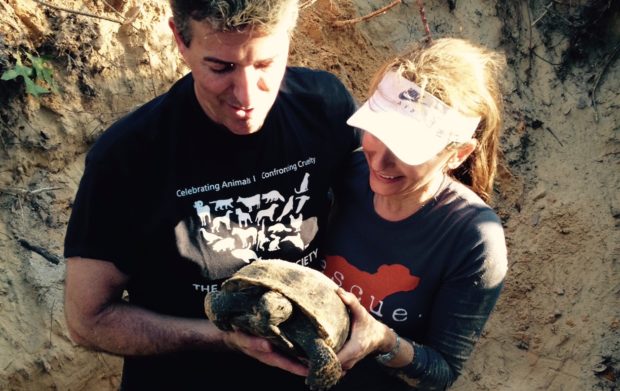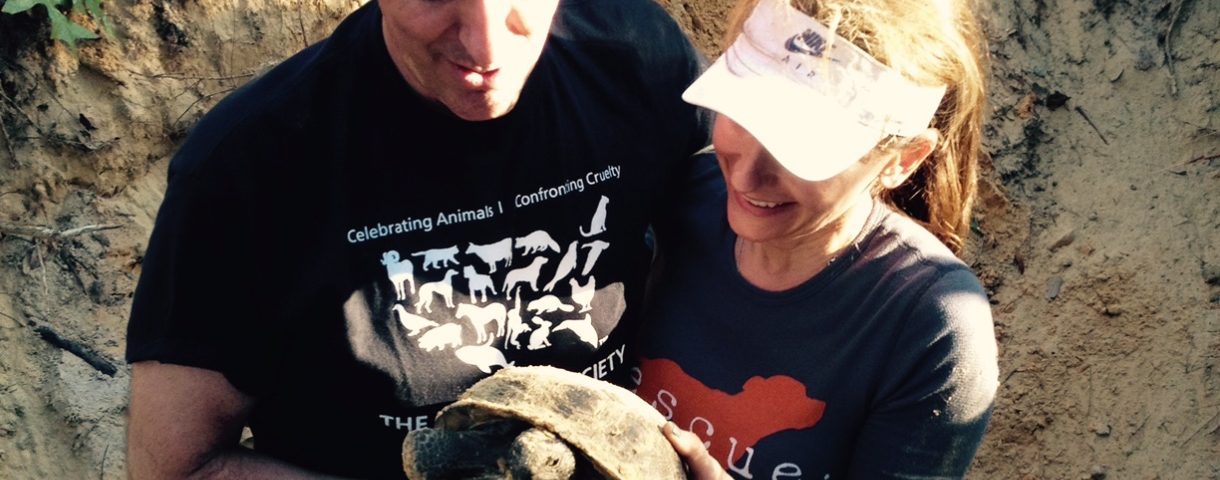A year ago, I would not have imagined I’d spend this Thanksgiving holiday with a shovel in hand, covered in powdery dirt, and digging 10 feet deep into the ground to find 15- to 30-pound gopher tortoises in central Florida.
It’s a bit of a needle in a haystack enterprise, but we had expert animal finders and teachers in Carissa Kent and Daryl Coggin, who operated a backhoe with such careful precision so as not to disturb the gopher tortoises or dozens of other species that also live in their intricate and often windy burrows. Once Carissa and Daryl spotted a burrow at the surface, they’d use a 10-foot pipe to gauge its depth and then dig out several feet of dirt. Then they’d send us in with shovels to uncover the tortoises safely nestled in their hideaways.

Wayne Pacelle and Lisa Fletcher remove a gopher tortoise from property slated for development. The tortoise will be relocated to safety. Photo credit: Carissa Kent
I got the idea of helping with tortoise rescue and seeing the process firsthand in April, when I trekked to the panhandle of Florida and visited the Nokuse Plantation, a private tract of land owned by the late M.C. Davis, a great animal advocate, which had become a new home for thousands of threatened gopher tortoises dug up by Carissa and her team.
So on Thanksgiving, we traveled as a family – my wife Lisa, my niece Morgan, and my nephew Owen – to Lecanto, Fla., where we joined Carissa and a couple of members of her team for the dig in Citrus County. Our goal was to save gopher tortoises and prevent them from being buried alive. These gentle and remarkable animals can live well past 80, but so many of them are in peril because we eat up their habitat and drive over them on the roads.
Carissa picked a site long slated for residential housing where the developer was legally permitted to bury and entomb the tortoises, since he had a valid “Incidental Take Permit” originally obtained by a different developer more than a decade ago. In this case, the developer, Ken Campbell, not only agreed to let us rescue the tortoises, but he donated $10,000 to The HSUS to conduct the operation. Credit is also due to environmental consultant Michael Czerwinski, who joined us for the dig on the second day of our adventure. We also had a great new partner in the U.S. Air Force, which is generously allowing the relocation of rescued tourists to Eglin Air Force Base, also in the panhandle.
It just so happens that Saving Florida’s Gopher Tortoises and The HSUS were celebrating a ten-year partnership to save tortoises. Since Carissa started the project – who teamed up with former HSUS Florida state director Jen Hobgood, with support from an array of individuals, including HSUS board member Jeff Arciniaco, who is a trustee of the Folke Peterson Foundation – there have been nearly 6,000 gopher tortoises removed and relocated to Nokuse, Eglin, private lands owned by conservationist Ted Turner, and a few other sites. Through similar partnerships, Saving Florida’s Gopher Tortoises has also assisted with the rescue, rehabilitation, release and/or placement of over 1,000 injured, sick, captive, and neglected tortoises. Carissa and her partner Dave, who is a Seminole County police officer, literally work around the clock, seven days a week, saving tortoises from the array of threats that plague them. Two finer people in our movement I have not met.
The HSUS works with Carissa on development sites that pre-date the upgrade in the law that requires humane removal of tortoises. From 1991 to 2007, the state granted permits to developers and they were literally allowed to pave over the lands and entomb the tortoises in their long burrows beneath the surface. The species was listed in 2007 as “threatened” under state law, and ITPs were no longer allowed as a permitting option; instead, the developers are now required to partner with people like Mike Czerwinski to survey the properties and relocate the threatened tortoises. But all ITPs granted prior to 2007 had been grandfathered, and these “take” permits never expire. So Carissa works with this set of developers to gain their permission to rescue the tortoises, and that’s what brought us to Citrus County on the holiday.
While the rescue was rewarding – and I was so happy my niece and nephew had the chance to do good, life-saving work – there’s still an immense amount of work to do. There are an estimated 15,000 to 25,000 tortoises still at risk on undeveloped/partially developed ITP sites. It’s estimated that it takes six months to a year for the tortoises to slowly suffer and die from suffocation, dehydration and starvation. That was all the incentive we needed to go to work over the Thanksgiving holiday.
On this blog, I’ve written that The HSUS and Humane Society International have a dizzying array of hands-on programs for animals. And this year, together with our affiliates we’ll break our prior record for animal care, help provide direct care to nearly 300,000 animals. If you want to support our tortoise rescue efforts, please make a restricted gift to enable us and Carissa to keep doing work that feels so good and saves so many lives.
The post If you dig tortoises, this program is for you appeared first on A Humane Nation.
Enviroshop is maintained by dedicated NetSys Interactive Inc. owners & employees who generously contribute their time to maintenance & editing, web design, custom programming, & website hosting for Enviroshop.
